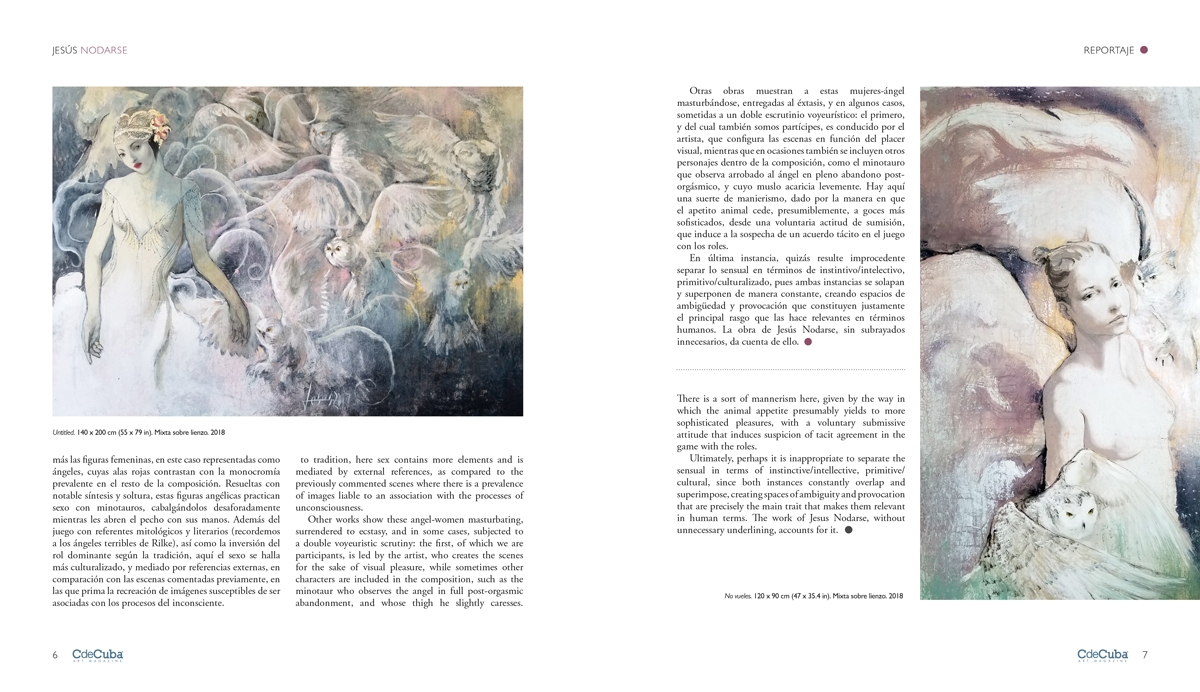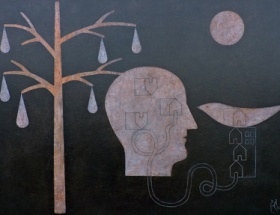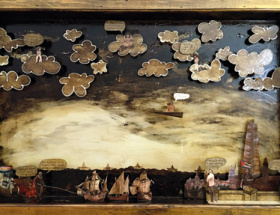Remembering Epicurus
By Carlos Jaime Jiménez
It is well-known that sexuality entails an impulse that is both fecundating and destructive, an act of violence usually physical, but whose most significant effects are revealed in the realm of the symbolic. Love-death, sex-decadence and eroticism-transgression are dual entities, present in all areas of the human cultural tradition, whether expressed through a voluntary exercise or as a result of latent motivations that have conditioned the symbolic production of various historical periods. Art is an ideal environment for the gestation of these processes, which are explored by creators through different exercises, at times marked by an analytical approach, other times by the chaotic freedom of the unconscious poured into the works, and, in some fortunate cases, by the combination of both aspects, something not at all easy to carry out.
In Jesus Nodarse’s visual art, particularly in its most recent stage, we can perceive the presence of both aspects, although always incorporated into what seems to be one of his fundamental concerns: the creation of highly sensual atmospheres, inhabited by characters whose attitudes range from provocative ambiguity to unleashed lubricity and lust. The leading role is almost exclusively played by women in dreamy spaces with certain interesting confluences. In one of the paintings we see a naked female body from behind, in midst of a translucent landscape, apparently underwater, but with marked spatial incongruities that point to the imaginary character of the scene. The young woman is surrounded by butterflies, a quasi exaggerated detail that confirms the impression of candidness and delicacy already perceptible from her pose and the gesture with which she covers her naked front. Behind and close to her is a creature with numerous tentacles, some of which he uses to hold a male individual who looks directly at the spectator. His attitude and gaze do not allow us to guess his intentions; it is not even clear if he was captured or surrendered voluntarily; all we can guess is that the real object of desire of both man and creature (perhaps they are projections of the same thing, after all), is the young woman, whose body seems to attract like a magnet the rest of the tentacles. There is an artificial component in this type of scene that emerges in opposition to its apparent linearity and simplicity. In them, what at first may be understood as innocent vulnerability also contains an implicit provocation.
In other works by the author we appreciate his interest to show highly sexual Dionysian-imbued scenes more directly, in which the game with cultural references nevertheless becomes even more evident. The medium chosen for these drawings is cardboard, and in them the leading role once again is played by the female figures, in this case represented as angels, whose red wings contrast with the prevailing monochrome in the rest of the composition. Solved with remarkable synthesis and ease, these angelic figures have sex with Minotaurs, riding them disproportionately while they opening their chests with the hands. In addition to playing with mythological and literary references (remember Rilke’s terrible angels), as well as the inversion of the dominant role according to tradition, here sex contains more elements and is mediated by external references, as compared to the previously commented scenes where there is a prevalence of images liable to an association with the processes of unconsciousness.
Other works show these angel-women masturbating, surrendered to ecstasy, and in some cases, subjected to a double voyeuristic scrutiny: the first, of which we are participants, is led by the artist, who creates the scenes for the sake of visual pleasure, while sometimes other characters are included in the composition, such as the minotaur who observes the angel in full post-orgasmic abandonment, and whose thigh he slightly caresses. There is a sort of mannerism here, given by the way in which the animal appetite presumably yields to more sophisticated pleasures, with a voluntary submissive attitude that induces suspicion of tacit agreement in the game with the roles.
Ultimately, perhaps it is inappropriate to separate the sensual in terms of instinctive/intellective, primitive/cultural, since both instances constantly overlap and superimpose, creating spaces of ambiguity and provocation that are precisely the main trait that makes them relevant in human terms. The work of Jesus Nodarse, without unnecessary underlining, accounts for it.






